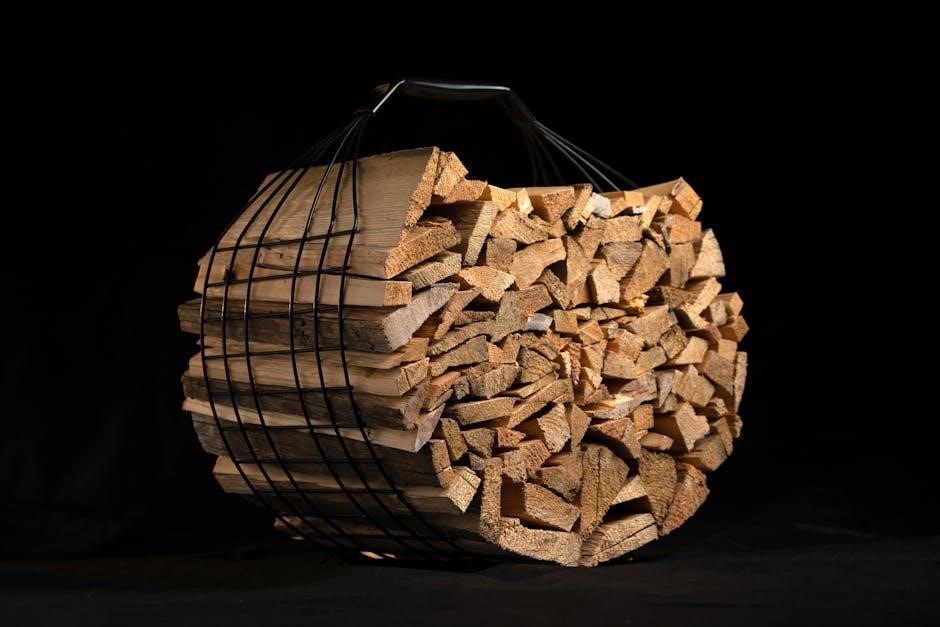
fireplace construction drawings pdf
Fireplace construction drawings provide detailed plans for building safe and functional fireplaces․ These diagrams ensure compliance with safety standards and building codes, offering clear CAD and PDF guides․
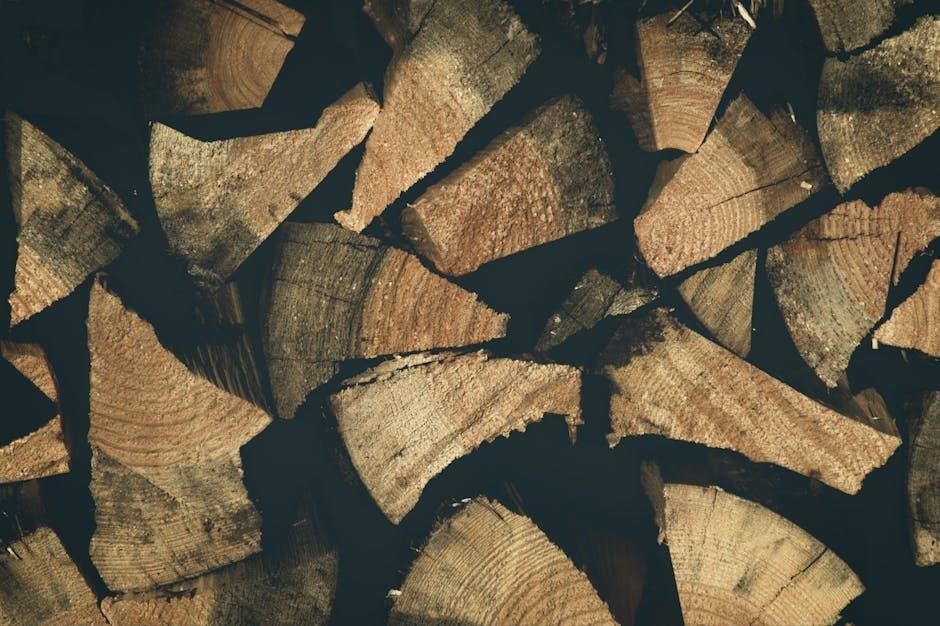
Types of Fireplaces
Fireplaces come in traditional, modern, and outdoor designs, each with unique constructions․ CAD and PDF plans provide detailed guides for their installation and customization․
2․1 Traditional Fireplaces
Traditional fireplaces are timeless designs, often constructed with masonry materials like brick or stone․ They typically feature a hearth, mantel, and chimney, requiring precise construction drawings․ These fireplaces are known for their rustic charm and durability․ CAD drawings and PDF guides provide detailed plans for their installation, ensuring safety and structural integrity․ They often include specifications for hearth extensions, clearance requirements, and ventilation systems․ Traditional fireplaces are popular for their aesthetic appeal and ability to blend into classic home designs․ Proper construction ensures efficient combustion and safe operation, making them a reliable choice for homeowners seeking a conventional fireplace experience․
2․2 Modern Fireplaces
Modern fireplaces emphasize sleek designs and efficiency, often featuring minimalist aesthetics․ They are constructed using materials like glass, steel, and engineered stone, offering a contemporary look․ These fireplaces frequently incorporate advanced ventilation systems and are available in vent-free or direct-vent models․ CAD drawings and PDF guides provide detailed instructions for installation, ensuring proper clearance and airflow․ Modern fireplaces are versatile, suitable for both indoor and outdoor settings, and often include customizable features․ Their designs prioritize functionality while maintaining a sophisticated appearance, making them a popular choice for modern homes․ Construction plans highlight precise measurements and material specifications to achieve optimal performance and safety․
2․3 Outdoor Fireplaces
Outdoor fireplaces are designed to enhance backyard spaces, providing a cozy gathering spot for cooler months․ Constructed from durable materials like masonry, brick, or stone, they withstand weather conditions․ These fireplaces often feature large fireboxes and chimneys, with detailed plans in CAD and PDF formats․ They require proper ventilation and clearance from flammable materials․ Outdoor fireplaces can be custom-designed to match landscaping, offering both functional and aesthetic benefits․ Construction drawings include specifications for drainage, ventilation, and safety features, ensuring safe operation․ Building an outdoor fireplace can be cost-effective and adds value to a home, creating a welcoming space for family and friends․
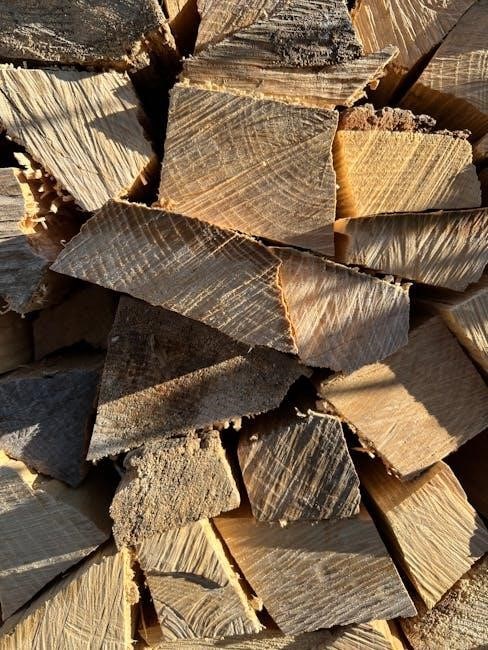
Essential Components of Fireplace Construction
Fireplace construction involves key components like the hearth, chimney, flue, damper, and mantel․ These elements ensure safety, functionality, and proper ventilation, as detailed in construction plans and guides․
3․1 Hearth Construction
The hearth is a critical component of fireplace construction, serving as the base where the fire burns․ It must be constructed from non-combustible materials, such as concrete or masonry, to ensure safety․ Building codes specify that the hearth must extend at least 8 inches on all sides of the fireplace opening and 16 inches in front․ Proper reinforcement and support are essential to withstand heat and weight․ Detailed PDF guides provide precise measurements and requirements for hearth construction, ensuring compliance with safety standards and regulations․ These plans also outline the necessary materials and techniques for a durable and functional hearth design․
3․2 Mantel Design and Installation
The mantel is both a decorative and functional component of a fireplace, serving as a surround for the fireplace opening․ Its design and installation must align with safety standards, ensuring proper clearance from combustible materials․ CAD drawings and PDF guides provide detailed measurements and layouts for mantel construction, helping to achieve precise fits and compliance with local building codes․ The mantel should be securely anchored to the wall to support its weight and any decorative elements․ Materials such as wood, stone, or metal are commonly used, offering durability and aesthetic appeal․ Proper installation ensures both safety and visual harmony in the room․
3․3 Chimney Structure and Safety
A well-constructed chimney is critical for safe fireplace operation, ensuring proper ventilation and preventing hazardous conditions․ Chimneys must be built on a solid foundation, typically with concrete footings, to support the structure’s weight․ Codes require chimneys to be constructed from non-combustible materials, such as masonry or metal, and to maintain proper clearance from combustible materials․ CAD and PDF guides provide detailed blueprints for chimney design, including flue sizing, liner specifications, and venting requirements․ Structural integrity and safety are paramount, with features like anchor straps securing the chimney to the building․ Proper construction ensures safe operation and compliance with local building codes․
3․4 Flue System Requirements
The flue system is a critical component of fireplace construction, ensuring safe and efficient ventilation of combustion gases․ Proper flue sizing, material selection, and installation are essential to maintain draft efficiency and prevent hazardous conditions․ Fireplace construction drawings in PDF and CAD formats detail flue requirements, including diameter, height, and clearance from combustible materials․ Flues must be constructed from durable, non-combustible materials, such as masonry or metal, and be properly insulated․ Additionally, flue liners are often mandated to contain and direct gases safely․ Compliance with local building codes and safety standards is non-negotiable to ensure a functional and secure fireplace system․ Detailed plans guide accurate installation and maintenance․
3․5 Damper Installation and Function
Dampers are essential components in fireplace systems, regulating airflow and ventilation․ Proper installation ensures they function correctly, controlling the intensity of fires and preventing heat loss when not in use․ Fireplace construction drawings in PDF and CAD formats provide detailed instructions for damper placement and sizing․ Dampers are typically made of metal and include a handle for operation․ They must be installed to allow full closure and ensure a tight seal․ Compliance with manufacturer guidelines and local building codes is crucial for safety and efficiency․ Accurate installation ensures optimal performance, maintaining proper ventilation and reducing risks associated with fireplace use․

Design Considerations for Fireplaces
Fireplace design involves selecting materials like stone, brick, or metal, ensuring proper clearances, and optimizing ventilation․ Plans must include precise dimensions and aesthetic integration into home interiors․
4․1 Standard Dimensions and Measurements
Standard dimensions for fireplaces ensure safety and functionality․ Hearths must extend at least 8 inches on each side and 16 inches in front of the opening․ For larger openings exceeding 6 square feet, hearth extensions increase to 12 inches on sides and 20 inches front․ Firebox dimensions typically range from 36 to 42 inches wide and 36 inches tall․ Overall heights, including the chimney, often reach 72 inches or more․ These measurements ensure proper proportions and structural integrity, adhering to building codes and safety standards for both indoor and outdoor fireplaces․ Accurate dimensions are critical for safe installation and efficient performance․
4․2 Choosing the Right Materials
Selecting appropriate materials for fireplace construction is crucial for safety and durability․ Masonry materials like brick, stone, and concrete are popular for their heat resistance and aesthetic appeal․ For fireboxes, refractory brick or concrete is recommended due to high heat tolerance․ Metal fireplaces often use steel or cast iron for durability․ When building an outdoor fireplace, weather-resistant materials such as natural stone or fire-rated brick are ideal․ Proper material selection ensures structural integrity and compliance with safety standards․ Always refer to construction drawings for specific material recommendations tailored to your fireplace design, whether it’s traditional, modern, or outdoor․
4․3 Clearance Requirements
Clearance requirements are critical for ensuring safety in fireplace construction․ Building codes mandate specific distances between combustible materials and fireplace components․ The hearth must extend at least 8 inches on each side and 16 inches in front of the fireplace opening․ For larger openings, clearances increase to 12 inches on the sides and 20 inches in front․ These measurements ensure that heat and sparks do not ignite nearby materials․ Fireplace construction drawings must clearly indicate these dimensions to comply with safety standards․ Proper clearance also applies to flammable materials near chimneys and vents, ensuring a safe installation and operation of the fireplace system․
4․4 Ventilation and Airflow Design
Ventilation and airflow design are essential for safe and efficient fireplace operation․ Proper airflow ensures the removal of combustion byproducts, such as carbon monoxide, through the flue system․ Fireplace construction drawings detail the flue size, height, and termination to optimize airflow․ A well-designed damper installation also regulates airflow, improving efficiency and reducing heat loss․ Outdoor fireplaces require additional ventilation considerations, such as airflow paths to prevent smoke accumulation․ CAD and PDF plans specify these elements, ensuring compliance with safety standards and building codes․ Proper ventilation design enhances both performance and safety, making it a critical aspect of fireplace construction․
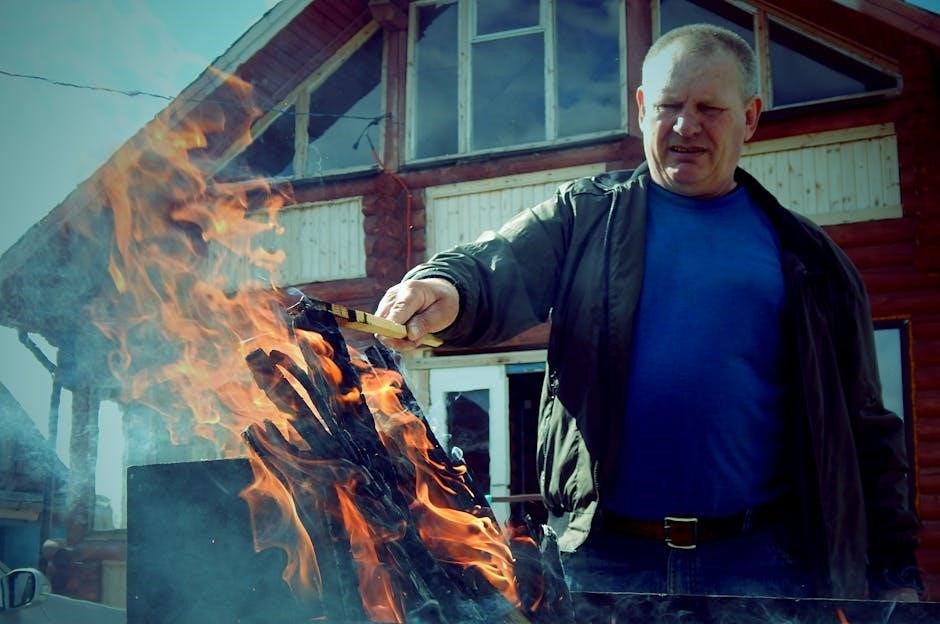
Safety Standards and Building Codes
Fireplace construction must adhere to strict safety standards and building codes, including hearth clearances and flue requirements․ Engineered plans ensure compliance, requiring professional approval for safe installation․
5․1 Relevant Building Codes
Relevant building codes for fireplace construction outline specific safety requirements, including hearth extensions and clearances․ Model codes mandate that hearths extend at least 8 inches on sides and 16 inches in front, increasing for larger openings․ These regulations ensure proper containment of sparks and heat․ Additionally, engineered plans and structural calculations signed by licensed professionals are required for approval․ Codes also address chimney construction, foundation requirements, and seismic considerations․ Compliance with these standards is essential to ensure fireplaces are safe, durable, and meet local regulations․ Proper documentation and inspections are typically required to verify adherence to these building codes․
5․2 Clearance to Combustible Materials
Clearance to combustible materials is a critical safety requirement in fireplace construction․ Building codes specify minimum distances between the fireplace and surrounding flammable materials to prevent fire hazards․ For example, combustible materials must be at least 8 inches away from the fireplace opening and 16 inches from the hearth extension․ These clearances ensure that heat and sparks do not ignite nearby materials․ Proper insulation and noncombustible barriers are often required to maintain these clearances․ Detailed in construction plans, these specifications help prevent accidental fires and ensure compliance with safety standards․ Adhering to these guidelines is essential for safe and durable fireplace installation․
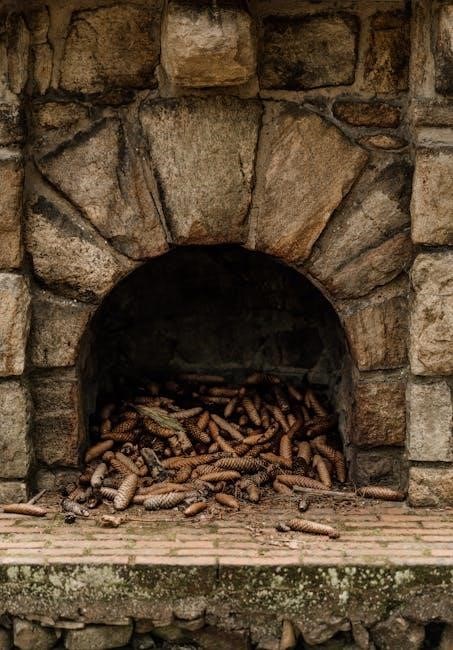
CAD Drawings for Fireplace Construction
CAD drawings provide precise plans for fireplace construction in DWG and PDF formats․ These detailed diagrams aid in designing and building fireplaces, ensuring accuracy and compliance with safety standards․
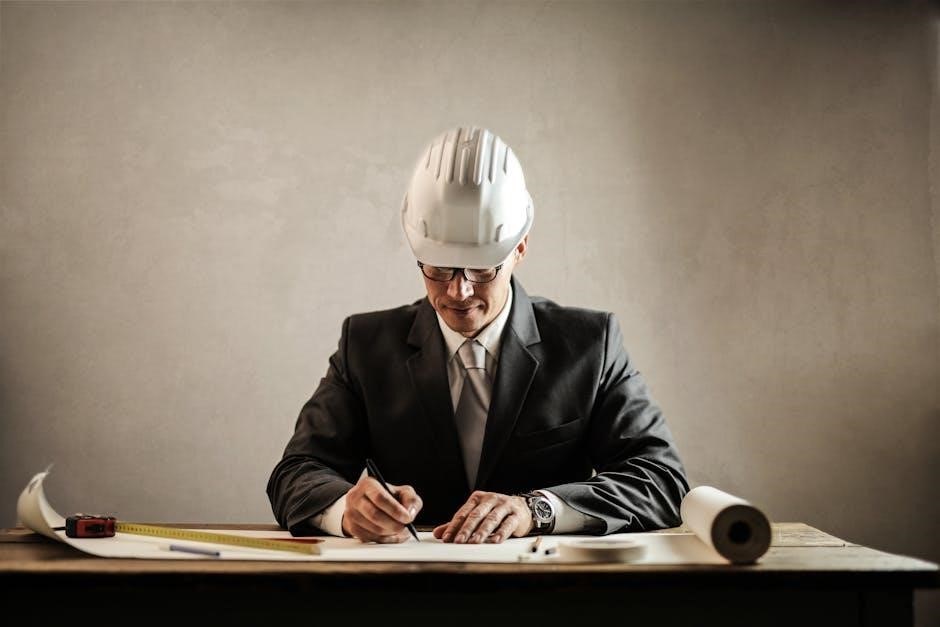
6․1 DWG Format Details
DWG format details are essential for precise fireplace construction planning․ These files, compatible with AutoCAD and other design software, offer detailed dimensional accuracy and material specifications․ DWG drawings provide comprehensive layouts, including hearth measurements, chimney structures, and flue systems․ They ensure compliance with building codes and safety standards, making them indispensable for contractors and architects․ DWG files also include annotations for installation guidelines, helping to streamline the construction process․ By using DWG format, professionals can easily modify designs to suit specific project requirements․ These detailed drawings are crucial for achieving accurate and safe fireplace installations, ensuring every component meets regulatory and structural demands․
6․2 PDF Format for Plans
PDF format for fireplace construction plans is widely used for its accessibility and clarity․ These documents provide detailed diagrams, dimensional layouts, and material specifications, ensuring precise construction․ PDFs are ideal for sharing and printing, making them a convenient option for contractors and homeowners․ They often include installation guides, clearance requirements, and safety standards, ensuring compliance with building codes․ Many resources offer free PDF downloads, such as masonry fireplace details and vent-free installation manuals․ PDF plans are versatile, catering to both indoor and outdoor fireplaces, and are compatible with various devices, making them a reliable choice for fireplace construction projects․
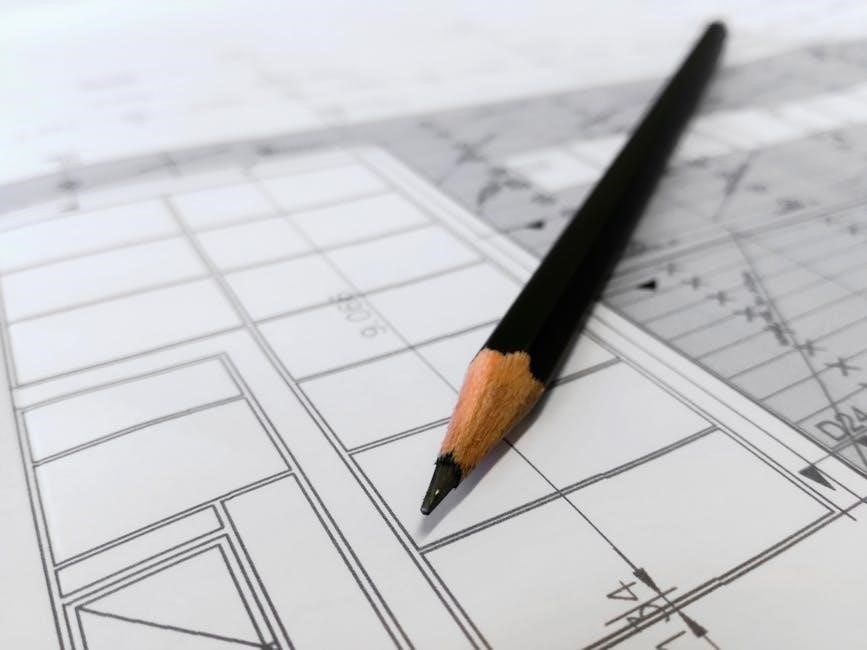
Installation Guides and Manuals
Installation guides and manuals provide step-by-step instructions for fireplace construction, ensuring safety and compliance with building codes․ They include detailed diagrams and material specifications for proper assembly and placement of components, such as vents, dampers, and hearths․ These resources are available in both digital and print formats, catering to various fireplace types, including vent-free and outdoor models․ Manuals often cover pre-installation preparation, tool requirements, and troubleshooting tips, making them essential for both professionals and DIY enthusiasts․ By following these guides, installers can achieve a safe and functional fireplace setup․
7․1 Pre-Installation Preparation
Pre-installation preparation is crucial for ensuring a safe and successful fireplace setup․ Begin by reviewing the construction drawings and manuals to understand the project scope․ Conduct a site evaluation to verify the location’s suitability, checking for level ground and proper clearance from combustible materials․ Gather all necessary tools and materials, referencing the provided lists in the installation guide․ Ensure the area is clean and free from debris to prevent obstacles during the process․ Measure and mark the space according to the dimensions outlined in the CAD drawings or PDF plans․ Verify local building codes and safety standards to avoid compliance issues․ Finally, prepare the foundation or base according to the specifications, ensuring it is level and sturdy to support the fireplace structure․
7․2 Essential Tools and Equipment
Having the right tools and equipment is vital for a successful fireplace installation; Essential items include a trowel for applying mortar, a level to ensure proper alignment, and a wheelbarrow or mixing bucket for mortar preparation․ A measuring tape and square are necessary for accurate measurements․ Safety gear like gloves and protective eyewear is crucial․ For masonry work, brick hammers and jointers are indispensable․ Ensure you have power tools such as drills and saws for cutting materials․ Reference the installation guide in the PDF or CAD drawings for specific tool recommendations tailored to your project; Proper equipment ensures efficiency and compliance with construction standards․
7․3 Outdoor Fireplace Specifics
Outdoor fireplaces require special considerations due to exposure to weather and outdoor conditions․ Durable materials like masonry, stone, or weather-resistant metals are recommended․ Proper ventilation and drainage systems must be incorporated to prevent water damage․ The construction should include a reinforced foundation to support the structure and ensure stability․ Clearance requirements for combustible materials must be strictly followed, often exceeding those of indoor fireplaces․ Design plans in PDF or CAD formats should detail these specifics․ Additionally, outdoor fireplaces may require additional features like chimneys with spark arresters or screens to contain embers․ Always consult local building codes and installation guides for compliance․
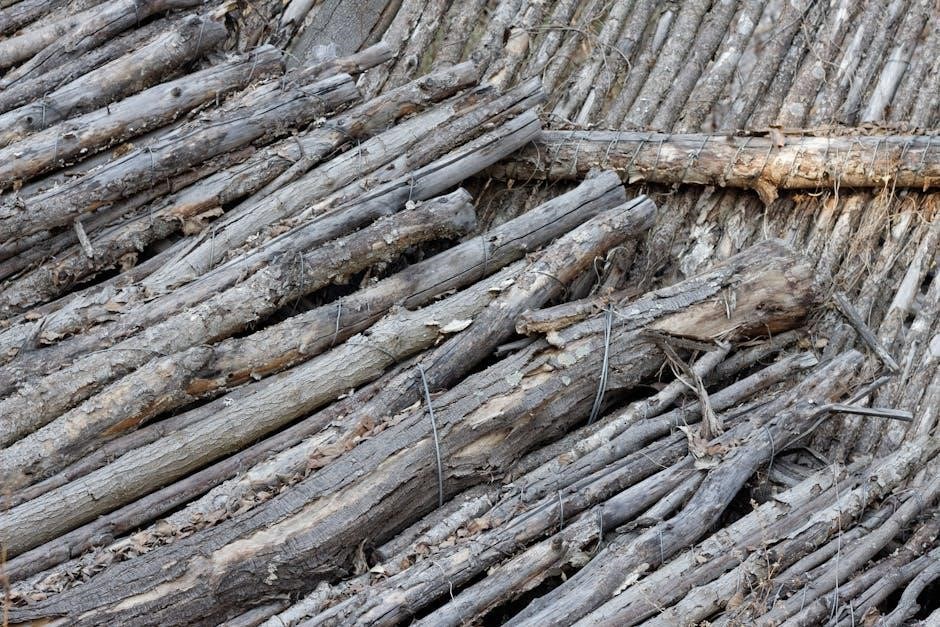
Permits and Approvals
Obtaining necessary permits and approvals is crucial before starting fireplace construction․ Ensure engineered plans and structural calculations are submitted for review, complying with local building codes and regulations․
8․1 Local Building Permits
Local building permits are essential for fireplace construction to ensure compliance with safety standards and building codes․ These permits require submission of engineered plans and structural calculations, signed by licensed professionals․ The plans must detail the fireplace’s design, materials, and installation methods, ensuring they meet local regulations․ Permits are issued after a thorough review to confirm adherence to fire safety and structural integrity requirements․ Failure to obtain necessary permits can result in legal consequences and potential safety hazards․ The permit process ensures that the construction meets all applicable codes and standards, guaranteeing a safe and compliant installation․
8․2 Engineered Plans Submission
Engineered plans for fireplace construction must be submitted for approval, ensuring compliance with local building codes and safety standards․ These plans, signed and stamped by licensed architects or civil engineers, include detailed structural calculations and drawings․ They must outline the fireplace’s design, materials, and installation methods, with specific attention to seismic requirements if applicable․ The submission process ensures that the construction adheres to safety protocols and load-bearing capacities․ Properly engineered plans are crucial for obtaining permits and guaranteeing the stability and safety of the fireplace and chimney structure․ This step is non-negotiable for both residential and outdoor fireplace projects․
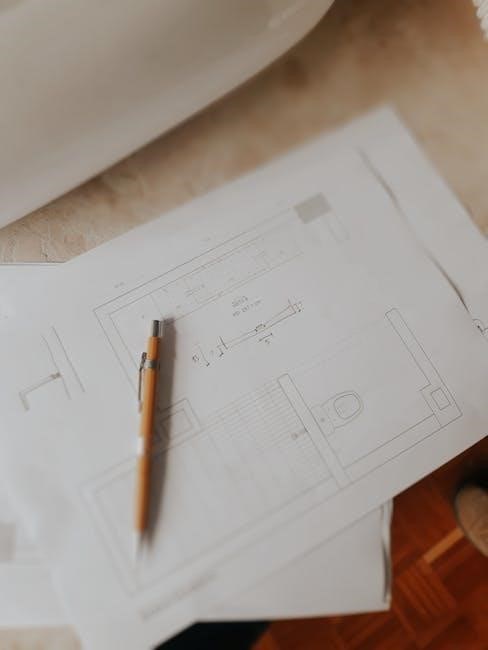
Custom Fireplace Designs
Custom fireplace designs allow homeowners to personalize their fireplace’s aesthetics and functionality․ These tailored plans offer unique features, ensuring the fireplace complements the home’s architecture and style perfectly․
9․1 Examples of Custom Drawings
Custom fireplace drawings offer a wide range of design possibilities, catering to unique architectural styles and personal preferences․ Examples include traditional, modern, and outdoor fireplaces, each with tailored dimensions and features․ These drawings often feature intricate details, such as arched openings, custom mantels, and decorative surrounds․ Materials like stone, brick, and metal are commonly specified, ensuring durability and aesthetic appeal․ Some designs incorporate see-through or corner fireplaces, providing a focal point in open living spaces․ Custom drawings also address specific installation requirements, such as ventilation systems and clearances, ensuring safety and functionality․ These detailed plans are available in CAD and PDF formats, making them accessible for professionals and DIY enthusiasts alike․
9․2 Tailored Dimensions and Features
Custom fireplace designs offer tailored dimensions and features to suit specific needs․ From standard hearth sizes to bespoke mantel heights, these drawings ensure a perfect fit for any space․ Materials like masonry, stone, or metal are often specified for durability and aesthetics․ Features such as arched openings, decorative surrounds, and vent-free systems can be included․ Dimensions are carefully calculated to meet local building codes and clearance requirements․ These custom plans are available in CAD and PDF formats, providing precise details for installation․ Whether for indoor or outdoor use, tailored designs ensure functionality, safety, and visual appeal․
Fireplace construction drawings are essential for ensuring safety, functionality, and compliance with building codes․ Whether in CAD or PDF formats, these detailed plans guide the construction of fireplaces, hearths, and chimneys․ By following these drawings, builders can achieve precise measurements, proper material selection, and adherence to safety standards․ Custom designs allow for tailored dimensions and features, while pre-drawn plans offer cost-effective solutions․ These resources are invaluable for professionals and DIY enthusiasts alike, ensuring that every fireplace project is well-planned and executed․ With the right drawings, a fireplace can become a safe, efficient, and beautiful focal point in any home․

Leave a Reply
You must be logged in to post a comment.